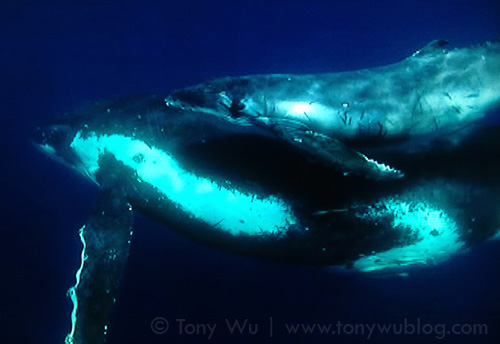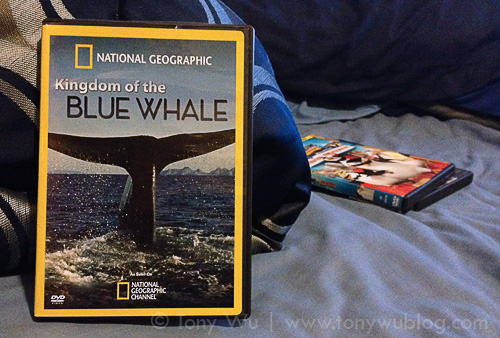Believe it or not, I confirmed another humpback whale mother/ calf pair ID while I was in Palau.
Now…before you commit electron to email and blast me with something along the lines of "Don't be a nimwit (again)!", please allow me to clarify.
I made the ID on TV.
Yes, that's right. On TV.
You see, during my recent stay in Palau, there were some days when I didn't go out on the water. On one of those occasions, I was chilling at my friend Ron's house, catching up on programs I've missed.
So get this: while I was engrossed in a documentary called Kingdom of the Blue Whale, I recognised a friend at the 40-minute mark!

I recognised this humpback whale female immediately!
When I say a "friend", I mean humpback whale mother #17 of the recent season in Tonga, which you can see in the picture above (snapshot of DVD footage on TV screen taken with my iPhone…how's that for digital whiz-bangery?)
Of course, I immediately broke out my 2012 humpback whale calf ID summary file to confirm the onscreen ID, but there was no doubt in my mind…the humpback whale female that appears in the documentary is the same female that is the mother of calf 201217 Juunana.
If you'd like to confirm this for yourself, download my humpback whale calf count summary, v3 (71 pages, 29MB) and refer to pages 34-36.
But wait. The story gets better.
The mother of 201217 is the first female humpback I've confirmed with three calves: 200816 (Chibi-chan), 200929 (Floppy), and 201217 (Juunana).
Recognising the adult whale in the video footage, of course, begged the question of whether the calf on TV was one of the three babies previously ID-ed, or perhaps a completely different one.
With a bit of deductive reasoning, I was able to figure out that it's different.
According to the DVD cover, the Kingdom of the Blue Whale was released in 2009 by National Geographic. Logically, this means that any footage in the video was taken before 2010.
I compared the DVD calf footage with images of calves 200816 and 200929, and it was clear that the babies do not match…which, of course, means that the footage must have been taken before the 2008 season…which, in turn, means that this female has had four babies that I can confirm with photo/ video proof.
Woohoo! You can imagine how giddy I was.
I rushed out, grabbed Ron, dragged him to the TV screen and spat out a convoluted concatenation of high-velocity syllables at him.
Being fluent in gibberish, Ron groked the situation right away, and commented that out of 6+ billion people on the planet, I'm probably the only person who could've made the connection.
We high-fived to mark the moment.
Anyway, I've updated my 2012 humpback whale calf count PDF file to reflect this exciting discovery. I don't, of course, know the exact year in which the footage incorporated in the DVD was taken.
If anyone has friends at National Geographic Television or National Geographic Channel who might be able to help suss out this bit of information, please put me in touch! (Click here to see back cover of DVD with production credits.)
Update 13 December: The humpback footage in the program was stock footage from BBC Motion Gallery. (Thanks to Michele Hall for tracking that lead down.)
I looked through the online BBC Motion Gallery and found the clip. It is dated 26 September 2002. So that means this I can document that this female humpback has had babies in 2002, 2008, 2009, 2012!

The National Geographic documentary with my humpback whale friend
(...and Penguins of Madagascar documentary DVDs in the background)
Note: Incidentally, I cross-checked all the mother/ calf pair IDs that I have to date for 2012 against those for 2008, 2009, 2010, 2011, and I did not find any more repeat mothers.